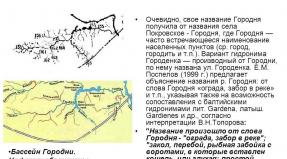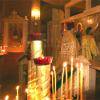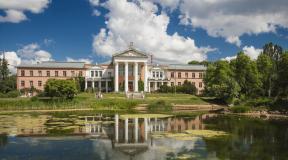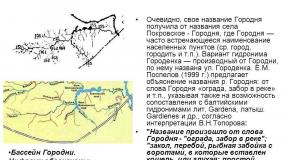Botanical gardens. Main Botanical Garden named after. N.V. Tsitsin RAS - description, history and interesting facts Description of the forest park area
Organizations that have documented collections of living plants are called botanical and are used for educational purposes, conservation of biological diversity, and participate in scientific developments and demonstrations. There are more than 2000 such organizations in the world, the list of botanical gardens in Russia reaches 73 units, all of them are united by the main goal - the conservation and use of plant resources to improve human well-being. Gardens have different geographical locations and are extremely important for the development of society as a whole. They contain a variety of varieties and types of plants.
The development of issues of garden construction and decorative structure occupies a key place in botanical gardens. Most of these organizations serve departments of botany at universities and operate as a base for educational institutions. Botanical gardens contribute to the growth of highly qualified specialists in the field of botany. Despite all these advantages, the main goal is the development and maintenance of the plant world.
History of the development of botanical gardens
The very first botanical gardens in Russia began to appear in St. Petersburg and Moscow. The purpose of their creation was to grow medicinal crops, but over time, other types of plants began to appear.
The history of the development of green areas has a close connection with the development of botany as a science. From the beginning of the 18th century, apothecary gardens began to appear in our country, growing valuable apothecary plants from which drugs were made. The spread of such gardens began during the reign of Peter I, in St. Petersburg, Voronezh, Moscow and many other cities.
The role of botanical gardens in the world
Floristic research and comprehensive forwarding activities have contributed to deepening the knowledge of the flora and plant nature of our country and all green crops around the world. Thanks to this, the rarest representatives of wild flora and new crops began to be developed. Botanical gardens systematically organize expeditions and trips, conduct comprehensive scientific research in the field of experimental botany, considering the main problems that plants face during acclimatization, and study environmental issues, biology, physiology and geographical location of plants. These studies had a beneficial effect on the mobilization of domestic resources.
Main Botanical Garden of the Russian Academy of Sciences named after N.V. Tsitsina
The main Russian museum of plant nature was created in Moscow in January 1945. Its fundamental goal was to preserve the rarest green areas - the Leonovsky forest and the Erdenevskaya grove, the area of which occupied more than 300 hectares. Architects Rosenberg and Petrov made a great contribution to the landscape design, thanks to which the garden was as close to natural conditions as possible.
Main Botanical Garden of the Russian Academy of Sciences named after N.V. Tsitsina collected in his collection more than 15,000 species of plant wealth, of which 1,900 are representatives of trees and shrubs, about 5,000 different species of plants from the tropics and subtropics, as well as a garden of endless flowering. This wildlife museum conducts excursions in its arboretum, during which visitors walking around the museum get acquainted with a huge variety of plant crops, learn about the benefits and harms of organisms, and also learn many new facts about indoor floriculture.

Amur Botanical Garden
The Amursk Botanical Garden was founded in 1994; its territory occupies 200 hectares. In this area there are about 400 representatives of vascular plants, of which 21 are listed in the Red Book. This museum participates in exhibitions, filming on television, and conducts lectures on landscape design.
The Amur Garden has three zones: the first zone is the island, the second is the right bank of the river, and the third is the administrative and economic area. A large area of forests belongs to nature reserves, and in some parts excursions are held, which are divided by complexity, distance, and age group of visitors. The Key Route has seven main locations.

St. Petersburg Botanical Garden at State University
The Botanical Garden of St. Petersburg State University is located in the city itself and suffers greatly from the effects of transport and environmental pollution. It began to be created in the 19th century. Active replenishment of the collection began in 1844, and in 1947 its official name was approved - the Botanical Garden at the State University. The main goal of this organization at that time was the educational process. The number of species had increased to 2,500 by 1896, and in 1901 an arboretum was founded.
This organization is a division of a state university, as a result of which its collection is selected in such a way that the educational process in botanical departments takes place visually. Thanks to this, students have the opportunity to gain in-depth knowledge in the study of botany. Botanical gardens of Russia make a valuable contribution to the development and education of society.
The area of the garden's greenhouse reaches 1,300 square meters, and the number of its representatives is 2,200 different varieties of subtropical and tropical crops, herbaceous plants, and shrubs. The garden’s collection also includes more than 800 species of cacti and succulents. An interesting fact is the presence of specimens that managed to live for more than 70 years.

The northernmost botanical garden in Russia
The botanical garden, located above the Arctic Circle, was founded in 1931. The goal of this project is to study the behavior of plants from different climates in a low temperature zone. Over the entire period of the garden’s existence, about 30,000 species of flora visited it, of which 3,500 were able to adapt to difficult conditions. Various studies are also carried out in the park.
The collection of the botanical garden includes more than 650 representatives of moss, more than 400 species of different plant crops, approximately 1000 varieties of wildlife from the subtropics and tropics. The number of visitors per year is more than 3,500 people. Snowdrops, living herbariums and a rock garden are some of the most unique representatives of this place. The garden also interacts with more than 30 countries around the world, with which it exchanges seeds and plant sprouts.

Great contribution to education
Botanical gardens are engaged in mass educational work. Many gardens have specialized nurseries that supply institutions and the public with planting and sowing materials. They also provide advisory support, give advice on the use and application of various plants, pay attention to botanical work in schools, create clubs for young botanists, and organize educational gardens for nature lovers.

Regardless of their directions, botanical gardens have a common important goal - the creation and maintenance of valuable plant crops and the dissemination of knowledge about living nature and the benefits of the living world for humans. The botanical gardens of Russia serve as a striking example of landscape design, and are also an excellent place for the population to relax, which awakens in people a love for the living area.
On February 14, 1706, on the northern outskirts of Moscow, behind the Sukharev Tower, Peter I founded the Apothecary Garden for growing medicinal plants. Nowadays the Botanical Garden of Moscow State University named after M.V. Lomonosov is one of the oldest botanical scientific institutions in Russia. Today we decided to talk about the seven most famous botanical gardens in Russia.
Apothecary garden in Moscow
The Apothecary Garden in Moscow or the Branch of the Botanical Garden of the Faculty of Biology of Moscow State University is the oldest botanical garden in Russia, which was founded by Peter I in Moscow in 1706. This botanical garden is also one of the oldest parks in Moscow. Initially, the Apothecary Garden was created in order to grow medicinal plants on its territory. There is a legend associated with this oldest garden that Peter himself personally planted three coniferous trees - spruce, fir and larch - in the newly created garden. Even under Peter, the garden was rich in greenhouses, rare plant species, and was also a favorite place for research by famous botanists.
Imperial Botanical Garden in St. Petersburg
The Imperial Botanical Garden in St. Petersburg, whose name now sounds like the Botanical Garden of the Botanical Institute. V.L. Komarova RAS is also one of the oldest botanical gardens in Russia. The garden itself is located on Aptekarsky Island in St. Petersburg. The garden was opened by Peter the Great in 1714. Today, this famous botanical garden in Russia is subordinate to the Botanical Institute named after V. L. Komarov, is its department and, accordingly, is part of the structure of the Russian Academy of Sciences. In the Botanical Garden of the BIN RAS, the plant collection includes more than eighty species. The museum's exposition at the garden is dedicated to the vegetation of the Earth, the history and evolution of plants, plant resources of Russia, as well as the relationship between plants and humans.
Biryulevsky Arboretum
Biryulyovsky Arboretum is one of the most famous gardens in Russia, which is located in Moscow. This garden is the second among Moscow parks in terms of the number of rare specimens of trees and shrubs. The arboretum is located in East Biryulyovo and is part of the Biryulyovo Forest Park. This garden was opened in 1938, but there is a certain secret connected with it, that the layout of the arboretum was already contained on the topographic map of the Moscow province of General Schubert in 1832. Now the Biryulyovsky Arboretum contains more than 250 rare species of trees, shrubs and other plants.
Botanical Garden of Tver State University

The Botanical Garden of Tver State University is the northernmost botanical garden in Russia with an exposition of steppe plants. The garden is located in the Zavolzhsky district of Tver, near the confluence of the Tvertsa and the Volga. Also, this unique garden of the Upper Volga region is an object of historical, cultural and natural heritage, more precisely, an archaeological monument. Initially, the garden was founded by the merchant of the First Guild I. Bobrov in 1879. At that time, oaks and larches were planted in the garden, which have survived to this day. This botanical garden features about 350 species of trees and shrubs, as well as more than 2,000 specimens of herbaceous plants. Eight exhibitions and six stock collections have also been created here. The ancient pond in the garden has been known since the 18th century.

The Polar Alpine Botanical Garden-Institute is located in the city of Kirovsk, Murmansk region, and is one of 11 institutes of the Kola Science Center of the Russian Academy of Sciences. This unique garden is the northernmost botanical garden in Russia, as well as one of the three gardens in the world located above the Arctic Circle. The decision to create a botanical garden in the Khibiny Mountains was made on August 26, 1931 with the participation of Academician A.E. Fersman. This botanical garden conducts research on the acclimatization of new plant species, their reproduction for the population, and other work. More than 400 plant species of the Murmansk region are collected here.
Main Botanical Garden named after N.V. Tsitsin RAS
The Main Botanical Garden named after N.V. Tsitsin RAS is the largest garden-institute in Russia, as well as the largest botanical garden in Europe, which has the richest collections of plants. The most interesting thing is that this garden presents the most diverse flora of all continents and climatic zones of our planet. This unique botanical garden is distinguished by a large number of exhibitions dedicated to plants of Russia, the tropics and other climatic zones. The garden's living collections include 8,220 species and 8,110 forms and varieties of plants. The garden was founded on April 14, 1945.
BOTANICAL GARDENS, scientific research, educational and cultural institutions that use collections of exotic plants and local flora in their work. On their basis, the diversity of the Earth's flora, the biology of individual taxa, and the patterns of introducing plants into culture (introduction) are studied. The main practical tasks of botanical gardens are to preserve in culture the most valuable, rare and endangered representatives of the flora, to search for new useful plants, to develop agricultural technology for their cultivation and propagation, to study the possibilities of returning extinct species to their original habitats in nature. For this, in addition to living collections, botanical gardens organize seed banks [the largest are in the Missouri Botanical Garden (USA) and the Royal Botanical Gardens, Kew (UK)], cryobanks for storing seeds and spores at ultra-low temperatures, laboratories for the propagation of especially valuable plants using biotechnological methods, etc. For the most part, botanical gardens are the basis for the educational work of pupils and students in botany, natural history, ecology, nature conservation, and garden design. In the expositions of botanical gardens, plants can be placed according to botanical-geographical, systematic or ecological principles, sometimes taking into account the history of the introduction of plants into culture. On the territory of the botanical garden, visitors get acquainted with the elements of landscape gardening art and the basic techniques of landscaping urban areas and interiors. Botanical gardens include arboretums, rock gardens, ponds and pools, greenhouses, areas of wild flora, cultivated plants, experimental nurseries, and the like. Many botanical gardens have large herbariums. Gardens often have botanical museums, various permanent and temporary exhibitions, etc.
The prototype of botanical gardens were the gardens of medicinal plants at monasteries (in Western Europe from the 4th century). The first university botanical gardens, which arose in Italy and Germany in the mid-16th century, also served mainly to introduce medicinal plants. During the era of the Great Geographical Discoveries, the collections of botanical gardens began to be replenished with exotic plants new to science. This process accelerated with the advent (at the end of the 16th century) of the first greenhouses in which tropical plants from the colonial possessions of Great Britain, France, the Netherlands, and Germany were grown. At the same time, the first private botanical gardens arose, for example Hortekamp in the Netherlands, Bergian Garden in Sweden. Living collections of botanical gardens are often arranged according to the systems of outstanding botanists - C. Linnaeus, A. Jussieux, D. Hooker, O. Decandolle, A. Engler, etc.
In Russia, the first botanical gardens can be considered the so-called Apothecary Gardens, founded by Peter I in Moscow (1706), St. Petersburg (1714), Lubny (1721) and other cities. University botanical gardens appeared at the beginning of the 19th century (at Moscow University on the basis of the Apothecary Garden, 1805). One of the first large private botanical gardens was founded by P. A. Demidov in 1756 in Moscow, on the Sparrow Hills. It collected over 4 thousand species of plants. The Demidov family also owned a botanical garden in Solikamsk (Perm region). Another famous and no less large botanical garden, created in 1798 in Gorenki near Moscow by Count A.K. Razumovsky, was an important botanical scientific center with world renown until 1825.
The first botanical garden of the Academy of Sciences was created in St. Petersburg in 1735 (a detailed catalog of its plants was compiled in 1736) and did not last long. After 1917, the number of botanical gardens in Russia increased sharply (by 1980 - 132). In 1952, at the All-Union Meeting of Botanical Gardens, they were united into a single network, the activities of which were coordinated by the Council of Botanical Gardens of the USSR (now the Council of Botanical Gardens of the Russian Federation). Their network includes 90 (as of 2004) gardens and similar botanical institutions subordinate to the Russian Academy of Sciences, universities and other departments of the Russian Federation. The most famous of them: the Main Botanical Garden named after N.V. Tsitsin RAS (Moscow), the botanical garden of the Botanical Institute named after V.L. Komarov (St. Petersburg), the Polar-Alpine Botanical Garden-Institute (Kirovsk, Murmansk region), Central Siberian Botanical Garden (Novosibirsk), etc.

Botanical gardens around the globe (more than 1000 in total) are united by the International Association of Botanical Gardens (IABG), founded in 1960, which has European and Asian branches. The largest foreign botanical gardens, whose living collections number 25-30 thousand species, are considered to be: Kew Botanical Gardens, New York Botanical Garden in the Bronx, Missouri Botanical Garden in St. Louis (USA), Berlin-Dahlem Botanical Garden (Germany). The northernmost is the Polar-Alpine Botanical Garden, the southernmost are the botanical gardens in Hobart (Tasmania) and Christchurch (New Zealand), the highest botanical garden (altitude 2100-2500 m) is in Khorog (Tajikistan).
Living collections of botanical gardens, seed banks and herbariums are replenished by expeditions and seed exchanges between botanical gardens. Based on herbaria and collections, various reference books are published (the very first of the major projects is the “Q Index” - a list of ever described species of vascular plants around the globe). Particular attention in botanical gardens is paid to the development of information retrieval systems that make it possible to summarize data on the diversity of plants in the collections of different botanical gardens and simplify the exchange of information. Such systems, in particular, have been created at the Missouri Botanical Garden, Kew Botanical Garden, and the Botanical Garden of Petrozavodsk University.
Lit.: Tsitsin N.V. Botanical Gardens of the USSR. M., 1974; Astrov A.V. Botanical gardens of Central Europe. M., 1976; Golovkin B.N. History of plant introductions in botanical gardens. M., 1981.
Organizations that have documented collections of living plants are called botanical gardens. The plants that make up them are used for education, conservation of biological diversity, and participate in scientific developments and demonstrations. There are more than 2000 such organizations in the world, the list of botanical gardens in Russia reaches 73 units, all of them are united by the main goal - the conservation and use of plant resources to improve human well-being. Gardens have different geographical locations and are extremely important for the development of society as a whole. They contain a variety of varieties and types of plants.

The development of issues of garden construction and decorative structure occupies a key place in botanical gardens. Most of these organizations serve departments of botany at universities and operate as a base for educational institutions. Botanical gardens contribute to the growth of highly qualified specialists in the field of botany. Despite all these advantages, the main goal is the development and maintenance of the plant world.
History of the development of botanical gardens
The very first botanical gardens in Russia began to appear in St. Petersburg and Moscow. The purpose of their creation was to grow medicinal crops, but over time, other types of plants began to appear.
The history of the development of green areas has a close connection with the development of botany as a science. From the beginning of the 18th century, apothecary gardens began to appear in our country, growing valuable apothecary plants from which drugs were made. The spread of such gardens began during the reign of Peter I, in St. Petersburg, Voronezh, Moscow and many other cities.
The role of botanical gardens in the world
Floristic research and comprehensive forwarding activities have contributed to deepening the knowledge of the flora and plant nature of our country and all green crops around the world. Thanks to this, the rarest representatives of wild flora and new crops began to be developed. Botanical gardens systematically organize expeditions and trips, conduct comprehensive scientific research in the field of experimental botany, considering the main problems that plants face during acclimatization, and study environmental issues, biology, physiology and geographical location of plants. These studies had a beneficial effect on the mobilization of domestic resources.
Main Botanical Garden of the Russian Academy of Sciences named after N.V. Tsitsina
The main Russian museum of plant nature was created in Moscow in January 1945. Its fundamental goal was to preserve the rarest green areas - the Leonovsky forest and the Erdenevskaya grove, the area of which occupied more than 300 hectares. Architects Rosenberg and Petrov made a great contribution to the landscape design, thanks to which the garden was as close to natural conditions as possible.
Main Botanical Garden of the Russian Academy of Sciences named after N.V. Tsitsina collected in his collection more than 15,000 species of plant wealth, of which 1,900 are representatives of trees and shrubs, about 5,000 different species of plants from the tropics and subtropics, as well as a garden of endless flowering. This wildlife museum conducts excursions in its arboretum, during which visitors walking around the museum get acquainted with a huge variety of plant crops, learn about the benefits and harms of organisms, and also learn many new facts about indoor floriculture.
Amur Botanical Garden
The Amursk Botanical Garden was founded in 1994; its territory occupies 200 hectares. In this area there are about 400 representatives of vascular plants, of which 21 are listed in the Red Book. This museum participates in exhibitions, filming on television, and conducts lectures on landscape design.
The Amur Garden has three zones: the first zone is the island, the second is the right bank of the river, and the third is the administrative and economic area. A large area of forests belongs to nature reserves, and in some parts excursions are held, which are divided by complexity, distance, and age group of visitors. The Key Route has seven main locations.
St. Petersburg Botanical Garden at State University
The Botanical Garden of St. Petersburg State University is located in the city itself and suffers greatly from the effects of transport and environmental pollution. It began to be created in the 19th century. Active replenishment of the collection began in 1844, and in 1947 its official name was approved - the Botanical Garden at the State University. The main goal of this organization at that time was the educational process. The number of species had increased to 2,500 by 1896, and in 1901 an arboretum was founded.
This organization is a division of a state university, as a result of which its collection is selected in such a way that the educational process in botanical departments takes place visually. Thanks to this, students have the opportunity to gain in-depth knowledge in the study of botany. Botanical gardens of Russia make a valuable contribution to the development and education of society.
The area of the garden's greenhouse reaches 1,300 square meters, and the number of its representatives is 2,200 different varieties of subtropical and tropical crops, herbaceous plants, and shrubs. The garden’s collection also includes more than 800 species of cacti and succulents. An interesting fact is the presence of specimens that managed to live for more than 70 years.
The northernmost botanical garden in Russia
The botanical garden, located above the Arctic Circle, was founded in 1931. The goal of this project is to study the behavior of plants from different climates in a low temperature zone. Over the entire period of the garden’s existence, about 30,000 species of flora visited it, of which 3,500 were able to adapt to difficult conditions. Various studies are also carried out in the park.
The collection of the botanical garden includes more than 650 representatives of moss, more than 400 species of different plant crops, approximately 1000 varieties of wildlife from the subtropics and tropics. The number of visitors per year is more than 3,500 people. Snowdrops, living herbariums and a rock garden are some of the most unique representatives of this place. The garden also interacts with more than 30 countries around the world, with which it exchanges seeds and plant sprouts.
Great contribution to education
Botanical gardens are engaged in mass educational work. Many gardens have specialized nurseries that supply institutions and the public with planting and sowing materials. They also provide advisory support, give advice on the use and application of various plants, pay attention to botanical work in schools, create clubs for young botanists, and organize educational gardens for nature lovers.
Regardless of their directions, botanical gardens have a common important goal - the creation and maintenance of valuable plant crops and the dissemination of knowledge about living nature and the benefits of the living world for humans. The botanical gardens of Russia serve as a striking example of landscape design, and are also an excellent place for the population to relax, which awakens in people a love for the living area.



















